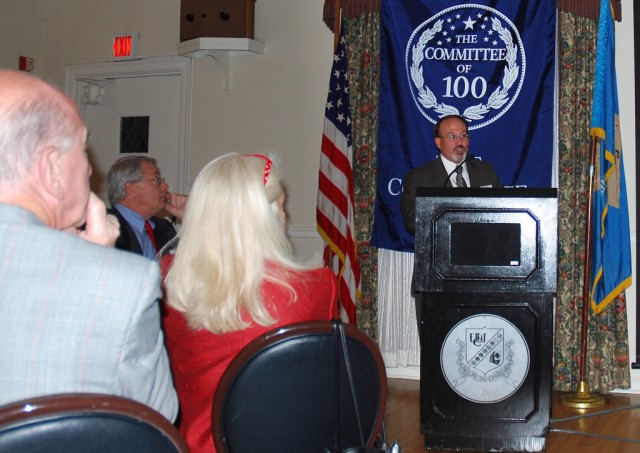WILMINGTON, Del. -- The base realignment and closure process is creating significant opportunities and challenges for Aberdeen Proving Ground, the installation's senior civilian leader told about 100 business and community leaders Oct. 19.
Gary Martin, U.S. Army Research, Development and Engineering Command executive deputy to the commanding general, said BRAC is bringing 8,500 jobs to the base. In 2015, APG will have about 22,000 military, government civilians, contractors and support personnel.
However, the installation faces many obstacles as workers from Fort Monmouth, N.J., and other military locations arrive in Harford County. Martin said the construction of new APG facilities is moving quickly, but transportation infrastructure is one of the region's greatest challenges.
"There is about $1 billion of construction and around 3 million square feet of labs, office space and special facilities," he said. "By April of next year, all of the construction will be done.
"From an infrastructure perspective, BRAC is done on the installation - brand new gates, brand new roadways coming into the post, brand new buildings for people to sit in. Now what's missing is - how do you get people to the fort'"
Road work at the U.S. 40/Maryland 715 intersection is scheduled to start in October and will take about two years. Five years after the BRAC announcement, it is the first major project on a primary intersection leading onto APG, Martin said.
"I hear this every day: 'I thought BRAC was coming.' They [local residents] don't see anything different outside the gate," he said. "The average person in Harford County says: 'I don't see anything that has changed.' For the most part, that's true. The infrastructure off the installation hasn't changed a bit."
Martin spoke at the University & Whist Club to the members of the Delaware Committee of 100, which is a business organization that promotes responsible economic development and addresses issues that affect Delaware, according to its Web site.
Another major challenge confronting APG is recruiting scientists to bolster APG's new status as the Army's hub for science and technology, Martin said.
"The personnel problem doesn't end when all the BRAC moves are done," he said. "If you look at the government population, roughly half of our population of existing workforce will be retirement eligible within the next five years."
Martin said that despite the looming retirements, the Army's mission continues. APG scientists must continue to provide the best technology to Soldiers.
APG and RDECOM have partnered with universities and community colleges to help fill the anticipated need for scientists.
RDECOM has signed cooperative research and development agreements with the University of Delaware, Morgan State University and the University of Maryland. Harford Community College opened a 2,325 square-foot training facility Sept. 28 near APG's Route 715 gate.
"We recognized in 2007 that our biggest challenge is going to be people. We knew the Army was going to put billions of dollars in construction, and they have. The buildings are fantastic," Martin said.
"We thought our biggest challenge was going to be getting the skill sets that we needed. We're shifting into high-tech. We're going to hire a lot of engineers, scientists and computer scientists."


Social Sharing